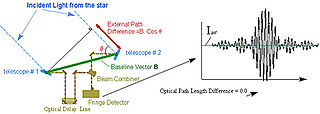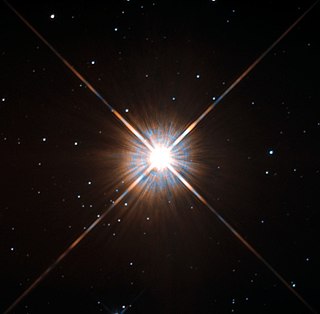Related Research Articles

Astrometry is a branch of astronomy that involves precise measurements of the positions and movements of stars and other celestial bodies. It provides the kinematics and physical origin of the Solar System and this galaxy, the Milky Way.

Alpha Centauri is a triple star system in the southern constellation of Centaurus. It consists of three stars: Rigil Kentaurus, Toliman (B) and Proxima Centauri (C). Proxima Centauri is also the closest star to the Sun at 4.2465 light-years.

Barnard's Star is a small red dwarf star in the constellation of Ophiuchus. At a distance of 5.96 light-years (1.83 pc) from Earth, it is the fourth-nearest-known individual star to the Sun after the three components of the Alpha Centauri system, and the closest star in the northern celestial hemisphere. Its stellar mass is about 16% of the Sun's, and it has 19% of the Sun's diameter. Despite its proximity, the star has a dim apparent visual magnitude of +9.5 and is invisible to the unaided eye; it is much brighter in the infrared than in visible light.

Space exploration is the use of astronomy and space technology to explore outer space. While the exploration of space is currently carried out mainly by astronomers with telescopes, its physical exploration is conducted both by uncrewed robotic space probes and human spaceflight. Space exploration, like its classical form astronomy, is one of the main sources for space science.

Proxima Centauri is a small, low-mass star located 4.2465 light-years (1.3020 pc) away from the Sun in the southern constellation of Centaurus. Its Latin name means the 'nearest [star] of Centaurus'. It was discovered in 1915 by Robert Innes and is the nearest-known star to the Sun. With a quiescent apparent magnitude of 11.13, it is too faint to be seen with the unaided eye. Proxima Centauri is a member of the Alpha Centauri star system, being identified as component Alpha Centauri C, and is 2.18° to the southwest of the Alpha Centauri AB pair. It is currently 12,950 AU (0.2 ly) from AB, which it orbits with a period of about 550,000 years.

Gaia is a space observatory of the European Space Agency (ESA), launched in 2013 and expected to operate until 2025. The spacecraft is designed for astrometry: measuring the positions, distances and motions of stars with unprecedented precision, and the positions of exoplanets by measuring attributes about the stars they orbit such as their apparent magnitude and color. The mission aims to construct by far the largest and most precise 3D space catalog ever made, totalling approximately 1 billion astronomical objects, mainly stars, but also planets, comets, asteroids and quasars, among others.

An interstellar probe is a space probe that has left—or is expected to leave—the Solar System and enter interstellar space, which is typically defined as the region beyond the heliopause. It also refers to probes capable of reaching other star systems.

Any planet is an extremely faint light source compared to its parent star. For example, a star like the Sun is about a billion times as bright as the reflected light from any of the planets orbiting it. In addition to the intrinsic difficulty of detecting such a faint light source, the light from the parent star causes a glare that washes it out. For those reasons, very few of the exoplanets reported as of April 2014 have been observed directly, with even fewer being resolved from their host star.

Transiting Exoplanet Survey Satellite is a space telescope for NASA's Explorer program, designed to search for exoplanets using the transit method in an area 400 times larger than that covered by the Kepler mission. It was launched on 18 April 2018, atop a Falcon 9 launch vehicle and was placed into a highly elliptical 13.70-day orbit around the Earth. The first light image from TESS was taken on 7 August 2018, and released publicly on 17 September 2018.

Breakthrough Listen is a project to search for intelligent extraterrestrial communications in the Universe. With $100 million in funding and thousands of hours of dedicated telescope time on state-of-the-art facilities, it is the most comprehensive search for alien communications to date. The project began in January 2016, and is expected to continue for 10 years. It is a component of Yuri Milner's Breakthrough Initiatives program. The science program for Breakthrough Listen is based at Berkeley SETI Research Center, located in the Astronomy Department at the University of California, Berkeley.
Breakthrough Initiatives is a science-based program founded in 2015 and funded by Julia and Yuri Milner, also of Breakthrough Prize, to search for extraterrestrial intelligence over a span of at least 10 years. The program is divided into multiple projects. Breakthrough Listen will comprise an effort to search over 1,000,000 stars for artificial radio or laser signals. A parallel project called Breakthrough Message is an effort to create a message "representative of humanity and planet Earth". The project Breakthrough Starshot, co-founded with Mark Zuckerberg, aims to send a swarm of probes to the nearest star at about 20% the speed of light. The project Breakthrough Watch aims to identify and characterize Earth-sized, rocky planets around Alpha Centauri and other stars within 20 light years of Earth. Breakthrough plans to send a mission to Saturn's moon Enceladus, in search for life in its warm ocean, and in 2018 signed a partnership agreement with NASA for the project.

Breakthrough Starshot is a research and engineering project by the Breakthrough Initiatives to develop a proof-of-concept fleet of light sail interstellar probes named Starchip, to be capable of making the journey to the Alpha Centauri star system 4.37 light-years away. It was founded in 2016 by Yuri Milner, Stephen Hawking, and Mark Zuckerberg.

Proxima Centauri b, sometimes referred to as Alpha Centauri Cb, is an exoplanet orbiting within the habitable zone of the red dwarf star Proxima Centauri, which is the closest star to the Sun and part of the larger triple star system Alpha Centauri. It is about 4.2 ly (1.3 pc) from Earth in the constellation Centaurus, making it, along with the currently-disputed Proxima c, and Proxima d the closest known exoplanets to the Solar System.
The future of space exploration involves both telescopic exploration and the physical exploration of space by robotic spacecraft and human spaceflight.

In December 2017, NASA released a mission concept involving the launch, in 2069, of an interstellar probe to search for signs of life on planets orbiting stars in and around the Alpha Centauri system. The announcement was at the annual conference of the American Geophysical Union The mission remains a concept, and as such, has no name or allocated funding.

BLC1 was a candidate SETI radio signal detected and observed during April and May 2019, and first reported on 18 December 2020, spatially coincident with the direction of the Solar System's closest star, Proxima Centauri.

Candidate 1 is an unconfirmed exoplanet candidate directly imaged around Alpha Centauri A in February 2021. If confirmed as an exoplanet, it would orbit at approximately 1.1 AU away from Alpha Centauri A with a period of about a year and would have a mass between that of Neptune and one-half that of Saturn and would therefore likely be a gas giant. Despite being a gas giant, due to its position in its orbit with Alpha Centauri A, it could have habitable moon(s) in its own orbit. The planet candidate is yet to be confirmed as an exoplanetary signal; additional observations are needed to confirm its true nature.
Peter G. Tuthill is an Australian astronomer who has pioneered the science of high-angular resolution astronomy, leading the development of aperture masking interferometry and astronomical optical interferometry. He is a professor of astrophysics at the School of Physics at the University of Sydney and was Director of the Sydney Institute for Astronomy (SIfA) of School from 2010 to 2015.
References
- ↑ Tuthill, Peter; Bendek, Eduardo; Guyon, Olivier; Horton, Anthony; Jeffries, Bryn; Jovanovic, Nemanja; Klupar, Pete; Larkin, Kieran; Norris, Barnaby; Pope, Benjamin; Shao, Mike (2018-07-09). "The TOLIMAN space telescope". In Tuthill, Peter G; Creech-Eakman, Michelle J; Mérand, Antoine (eds.). Optical and Infrared Interferometry and Imaging VI. Vol. 10701. SPIE. pp. 432–441. Bibcode:2018SPIE10701E..1JT. doi:10.1117/12.2313269. ISBN 9781510619555. S2CID 125614282.
- ↑ "40 trillion kilometres is a long way to look but this Sydney-designed custom telescope is up to the task". ABC News. 2021-11-16. Archived from the original on 2021-11-17. Retrieved 2021-11-20.
- ↑ "Are we alone? University and EnduroSat join up in search for life among the stars". April 2023.
- ↑ "The TOLIMAN mission: precision astrometry for exoplanetary discovery in the solar neighborhood" (PDF). Archived (PDF) from the original on 2021-11-17. Retrieved 2021-11-20.
- ↑ "New mission to scour our interstellar neighbourhood for planets that could sustain life". the Guardian. 2021-11-16. Archived from the original on 2021-11-17. Retrieved 2021-11-20.